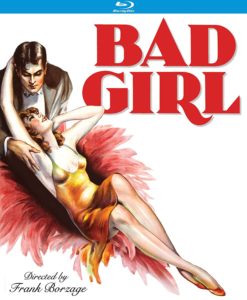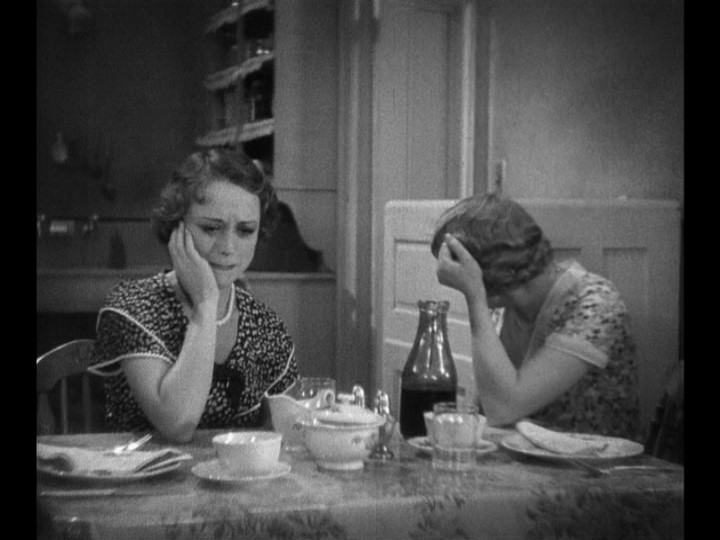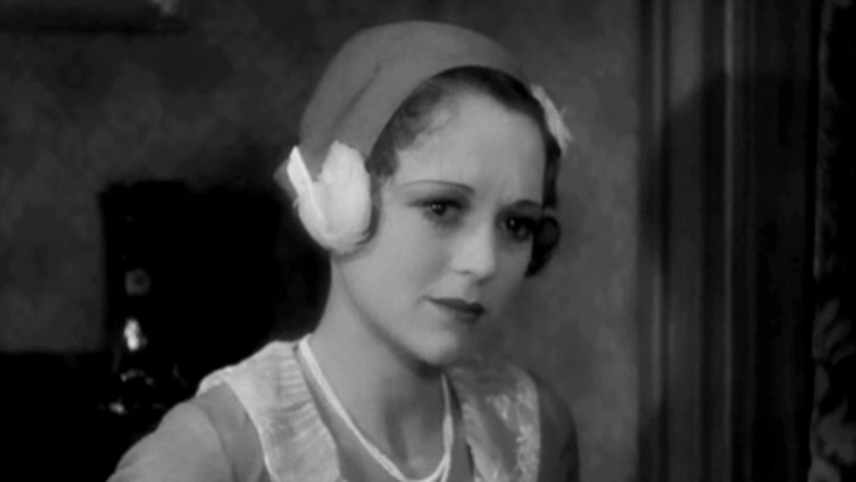Great Depression Era Social Drama is Pretty Okay
DIRECTED BY FRANK BROZAGE/1931
STREET DATE: DECEMBER 13, 2016/KINO LORBER STUDIO CLASSICS
 Based on a novel by Viña Delmar, 1931’s relationship drama Bad Girl proved to be a huge hit in the pre-code/early talkie era.
Based on a novel by Viña Delmar, 1931’s relationship drama Bad Girl proved to be a huge hit in the pre-code/early talkie era.
James Dunn and Sally Eilers play rocky young lovers Eddie and Dorothy. Eilers, with her doughy eyes and palpable fragility, scarcely warrants the film’s title. By today’s standards, her outwardly flirty demeanor and implied “loose” ethics are completely unrecognizable as anything resembling “bad”. Nor do her being led around by the hand by her brother’s wife (played by Mina Gombel). The title, racy poster, and the rest of the marketing, however, served its purpose in conjunction with the rest of the competent work on display to elevate the movie into hit.
The film’s success brought then-floundering director Frank Borzage back to the fold as a major director at Fox. Known for his storytelling sensitivity, Borzage had been a reliable behind-the-camera talent going back to the silent era, but prior to this film, his luck had run out.
Eilers, with her doughy eyes and palpable fragility, scarcely warrants the film’s title. By today’s standards, her outwardly flirty demeanor and implied “loose” ethics are completely unrecognizable as anything resembling “bad”.
Perhaps Borzage could relate to the downward plight of Eddie, already a cynical ne’er-do-well. All Eddie wants is to own his own radio shop, although his frequency is prone to change. This stems from his questionable cultural believes that lead to pronouncements such as: “Listen, I’m the husband…! It’s my job to make you happy. If a husband ain’t for that, he ain’t for nothin’!”
His early 1930’s-male barking cadence mixed with his staunchness admittedly takes its toll, similar to Denzel Washington’s not dissimilar freight train of a personality in 2016’s Fences. It should be said, though, that Eddie’s vast variations on “Okay!” play as an endearing trait, as opposed to the Coen Brothers-esque approach in which such a thing would be handled with today. It’s debatable whether or not his repeated references to Dorothy’s mind as her “nut” outweigh his “okay”s.

Sally Eilers and Mina Gombel in BAD GIRL (1931).
The Kent Jones commentary, newly created for this blu-ray, is a strong selling point for film buffs. Just as he did in the making of his documentary Hitchcock/Truffaut, Jones’ sets aside his trademark dense but eloquent writing style to speak in a more conversational way. As wisely approachable as this method is, Jones’ track, while highly informative, also sounds like a late night one-take affair, full of pauses and on-the-spot thought formulation. While far from a deal breaker, and still worthy of one’s time, there is an unavoidable laconic quality in listening to this master that invites caffeine.
Jones points out on his commentary track how the world of Bad Girl is particularly contained to the main characters and their apartment, something not uncommon to Borzage or films of this time. Tin ceilings, looming wood staircases, plain walls- all tenants of claustrophobic tenements of Depression era Hollywood social dramas – are ever threatening the leads for center stage. Yet, even when the characters leave the tenement, to, for instance, spend untold weeks away from home having a baby, the walls of those other locations (sets) are always devoid of visual clutter, as to dare not compete with the actors for attention. Although competent, Dunn and Eilers were not major stars, this seems to be the film’s way of handling them accordingly.

The face of a Bad Girl?
Kent Jones, it must be said, is far more in love with Bad Girl than I am. My wife, after only seeing a portion of the film, declared the film a frustrating affair. “If these characters would just say what the hell they’re feeling, and stop trying to manage one another, their whole drama could be easily avoided!” (Again, similar to Fences – but with 100% less backyard.) Quickly followed by, “But then, there’d be no movie.” So yeah, this is one of those stories.
Not many pre-code films have made their way to blu-ray, so in that aspect alone, this release is something film buffs should support. The transfer satisfies with its black & white, film-grainy patina. There are a few jump cuts that appear unintentional, likely stemming from the condition of the otherwise decent print that was scanned this effort. The film sounds crisp and present, not tinny and poppy which can sometimes be the case with very old films.
Bad Girl may not be the greatest of its ilk, but it’s not at all bad, either.
The images in this review are not representative of the actual Blu-ray’s image quality, and are included only to represent the film itself.

